如何写好论文introduction
introduction 写作方法
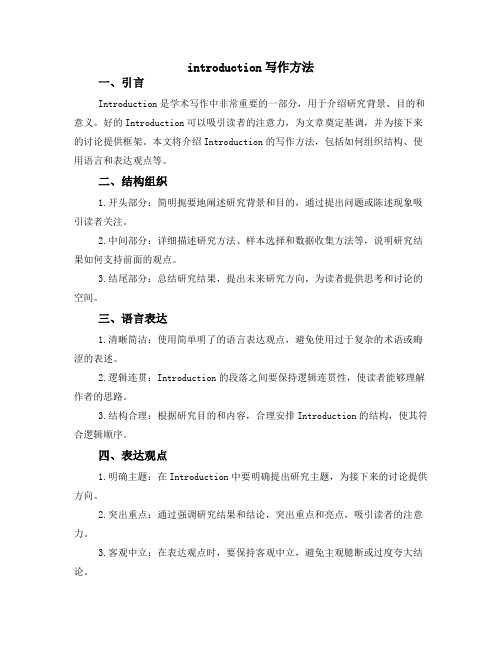
introduction写作方法一、引言Introduction是学术写作中非常重要的一部分,用于介绍研究背景、目的和意义。
好的Introduction可以吸引读者的注意力,为文章奠定基调,并为接下来的讨论提供框架。
本文将介绍Introduction的写作方法,包括如何组织结构、使用语言和表达观点等。
二、结构组织1.开头部分:简明扼要地阐述研究背景和目的,通过提出问题或陈述现象吸引读者关注。
2.中间部分:详细描述研究方法、样本选择和数据收集方法等,说明研究结果如何支持前面的观点。
3.结尾部分:总结研究结果,提出未来研究方向,为读者提供思考和讨论的空间。
三、语言表达1.清晰简洁:使用简单明了的语言表达观点,避免使用过于复杂的术语或晦涩的表述。
2.逻辑连贯:Introduction的段落之间要保持逻辑连贯性,使读者能够理解作者的思路。
3.结构合理:根据研究目的和内容,合理安排Introduction的结构,使其符合逻辑顺序。
四、表达观点1.明确主题:在Introduction中要明确提出研究主题,为接下来的讨论提供方向。
2.突出重点:通过强调研究结果和结论,突出重点和亮点,吸引读者的注意力。
3.客观中立:在表达观点时,要保持客观中立,避免主观臆断或过度夸大结论。
五、示例分析以下是一个Introduction的示例分析:1.开头部分:通过描述一种普遍存在的社会现象,引出研究主题。
2.中间部分:介绍研究方法、样本选择和数据收集方法等,说明研究结果如何支持前面的观点。
同时,通过与其他类似研究的比较,突出本研究的创新点和贡献。
3.结尾部分:总结研究结果,提出未来研究方向,并引导读者思考相关问题。
六、总结好的Introduction是学术文章成功的一半,它能够吸引读者的注意力,为文章奠定基调,并为接下来的讨论提供框架。
通过组织结构、使用语言和表达观点等方面的技巧,可以提高Introduction的写作质量。
希望本文的介绍对大家有所帮助。
SCI论文引言部分Introduction的写作
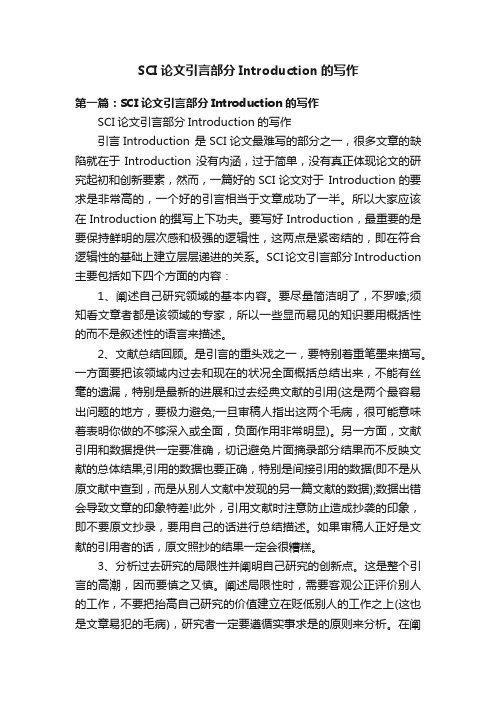
SCI论文引言部分Introduction的写作第一篇:SCI论文引言部分Introduction的写作SCI论文引言部分Introduction的写作引言Introduction 是SCI论文最难写的部分之一,很多文章的缺陷就在于Introduction没有内涵,过于简单,没有真正体现论文的研究起初和创新要素,然而,一篇好的SCI论文对于Introduction的要求是非常高的,一个好的引言相当于文章成功了一半。
所以大家应该在 Introduction的撰写上下功夫。
要写好 Introduction,最重要的是要保持鲜明的层次感和极强的逻辑性,这两点是紧密结的,即在符合逻辑性的基础上建立层层递进的关系。
SCI论文引言部分Introduction 主要包括如下四个方面的内容:1、阐述自己研究领域的基本内容。
要尽量简洁明了,不罗嗦;须知看文章者都是该领域的专家,所以一些显而易见的知识要用概括性的而不是叙述性的语言来描述。
2、文献总结回顾。
是引言的重头戏之一,要特别着重笔墨来描写。
一方面要把该领域内过去和现在的状况全面概括总结出来,不能有丝毫的遗漏,特别是最新的进展和过去经典文献的引用(这是两个最容易出问题的地方,要极力避免;一旦审稿人指出这两个毛病,很可能意味着表明你做的不够深入或全面,负面作用非常明显)。
另一方面,文献引用和数据提供一定要准确,切记避免片面摘录部分结果而不反映文献的总体结果;引用的数据也要正确,特别是间接引用的数据(即不是从原文献中查到,而是从别人文献中发现的另一篇文献的数据);数据出错会导致文章的印象特差!此外,引用文献时注意防止造成抄袭的印象,即不要原文抄录,要用自己的话进行总结描述。
如果审稿人正好是文献的引用者的话,原文照抄的结果一定会很糟糕。
3、分析过去研究的局限性并阐明自己研究的创新点。
这是整个引言的高潮,因而要慎之又慎。
阐述局限性时,需要客观公正评价别人的工作,不要把抬高自己研究的价值建立在贬低别人的工作之上(这也是文章易犯的毛病),研究者一定要遵循实事求是的原则来分析。
introduction的写作方法
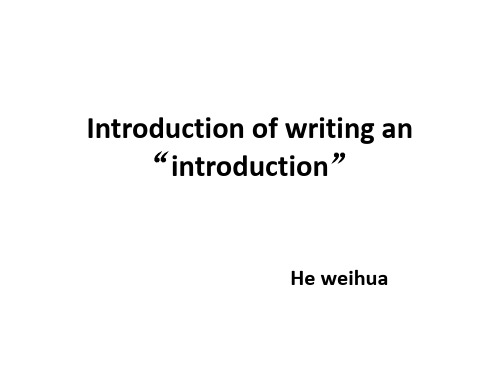
各个Move的写作要点
Move one 关键点: 热点,难点,急需 时态一般为现在完成时 Move two 关键点: 引用 时态运用 涉及到某项具体研究—过去式 涉及到研究的问题和领域—现在完成时 陈述现在的认识(当前成果)—现在时 Move three 关键点:否定的起始 指出前人研究的不足、不尽之处。 比如对于……,我们的认识还十分有限; 然而对于……,已报道的数据十分有限等。 Move four 关键点: 研究目的和意义 填补空白,完成任务,解决问题
Move one 说明研究领域 I.指明中心
1.兴趣 2.重要性 3.重要论题 4.标准程序(方法、工艺)
II.陈述现有知识 III.描述重要特征 Move two 总结前人研究 Move three 本研究的必要性 I. 指出差距 II.提出问题(任务) III. 延伸认识 Move four 介绍本研究 I. 研究用途(效果) II. 描述与介绍 introduction至少包括前三个部分 By John swales
以研究者为受众的文章introduction
这类文章的introduction对问题的阐述方式有 详有略。
对于一些共识性的假说、方法和知识,往 往不会详加阐述。
但是会包括一些技术细节,和在这一问题 上对前人的工作做一个总结。 在此基础上,作者对前人理论和方法做出 评述,或者指出不足。
Article introduction 的结构
OVER
Introduction of writing an “introduction”
He weihua
The beginning is half of the whole
—好的开始是成功的一半
“Introduction”是论文写作中非常棘手 的部分
introduction 写作要点

introduction写作要点
introduction写作要点如下:
1.明确主题:在引言中明确指出研究的主题或领域,让读者对文章的主要内容有所了解。
2.背景介绍:简要介绍研究主题的背景信息,说明研究的必要性和重要性。
这有助于建立研究问题的上下文,并为后续的讨论和论证提供依据。
3.研究问题陈述:明确提出研究问题或假设,并简要说明为什么这个问题或假设重要。
确保问题或假设具体、明确,并具有针对性。
4.文献综述:概述与主题相关的先前研究,指出现有研究的不足之处,以及本研究如何填补这些不足。
这有助于确立研究的理论基础和出发点。
5.研究方法:简要说明将采用的研究方法或技术,以及选择这些方法的原因。
这可以为后续的实验或调查提供指导。
6.研究意义:阐述本研究对理论和实践的意义,强调其对特定领域或更广泛的社会、经济、政治等方面的贡献。
7.组织结构:概述文章的结构和主要内容,为读者提供导航指南。
可以简要介绍每个部分的主题和要点。
8.语言和风格:保持引言的语言清晰、简洁,并尽量使用客观、中性的语言。
避免过多的行话和专业术语,以便让更广泛的读者能够理解。
9.引用和参考文献:在引言中引用的观点、数据或结论时,应注明出处。
确保遵循所使用的引用格式要求,并在文末提供完整的参考文献列表。
10.激发读者兴趣:通过提出引人入胜的问题、强调研究的创新点或挑战传统观念的观点等,激发读者对后续内容的兴趣。
论文写作中的介绍与背景部分撰写技巧

论文写作中的介绍与背景部分撰写技巧在撰写学术论文时,介绍(Introduction)和背景(Background)部分往往被认为是整篇论文的基石,它们为读者提供了对研究问题、研究目的和现状的全面认识,并引导读者对后续内容的理解。
正确撰写介绍和背景部分既能够激发读者的兴趣,又能够明确研究的价值和意义。
本文将就论文写作中的介绍与背景部分撰写技巧进行探讨。
一、介绍部分撰写技巧介绍部分通常应包含以下内容:1. 研究背景:简要叙述研究领域的现状与问题,指出该领域尚未解决的难题。
可以引用前人的研究成果和观点,以及相关数据和统计结果,旨在引发读者对该问题的兴趣。
2. 问题陈述:明确指出本研究的研究目的、关注的问题或假设,并解释为什么这个问题或假设值得研究。
应确保问题陈述简明扼要,清晰明了。
3. 目标与意义:阐明本研究的目标和意义,即为什么要进行该研究以及该研究的重要性和价值。
可以基于前人的研究成果,强调本研究的创新点和现实应用价值。
4. 结构与内容安排:简要描述本文的结构和各章节内容,告知读者整篇论文的组织结构,使读者能够清晰地理解各个部分的关系。
撰写介绍部分的技巧如下:1. 语言简明扼要:介绍部分应避免冗长的叙述和复杂的句子结构,应以简明扼要的语言进行表达,使读者能够迅速抓住文章的核心内容。
2. 逻辑严谨:介绍部分的内容应按照逻辑顺序进行阐述,确保读者能够清晰地理解研究的背景、问题和研究目标。
可以采用递进的方式,由整体到局部,由宏观到微观地逐步展开。
3. 吸引读者兴趣:撰写介绍部分时,可以采用一些引人入胜的方式,如引用令人惊奇的事实、提出引发思考的问题、讲述真实的案例等,以引发读者的兴趣并使其愿意继续阅读下去。
二、背景部分撰写技巧背景部分通常应包含以下内容:1. 相关理论:对当前研究领域的主要理论、概念和术语进行解释和介绍,以确保读者对后续内容的理解。
2. 相关研究:对前人在该研究领域的相关研究进行概括和总结,分析前人研究的不足之处和存在的问题,指出本研究的创新点和改进之处。
SCI科技论文Introduction四步法写作技巧
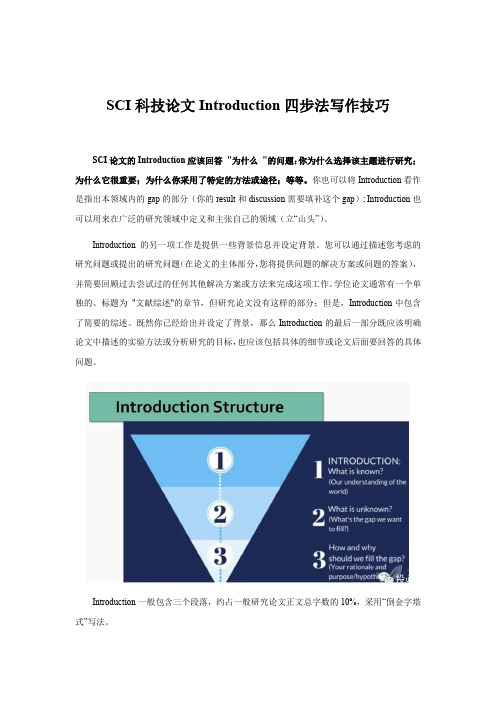
SCI科技论文Introduction四步法写作技巧SCI论文的Introduction应该回答"为什么"的问题:你为什么选择该主题进行研究;为什么它很重要;为什么你采用了特定的方法或途径;等等。
你也可以将Introduction看作是指出本领域内的gap的部分(你的result和discussion需要填补这个gap); Introduction也可以用来在广泛的研究领域中定义和主张自己的领域(立“山头”)。
Introduction的另一项工作是提供一些背景信息并设定背景。
您可以通过描述您考虑的研究问题或提出的研究问题(在论文的主体部分,您将提供问题的解决方案或问题的答案),并简要回顾过去尝试过的任何其他解决方案或方法来完成这项工作。
学位论文通常有一个单独的、标题为"文献综述"的章节,但研究论文没有这样的部分;但是,Introduction中包含了简要的综述。
既然你已经给出并设定了背景,那么Introduction的最后一部分既应该明确论文中描述的实验方法或分析研究的目标,也应该包括具体的细节或论文后面要回答的具体问题。
Introduction一般包含三个段落,约占一般研究论文正文总字数的10%,采用“倒金字塔式”写法。
四步法写Introduction1. 提供背景资料,设置背景Introduction的这一初始部分为读者准备了后面更详细、更具体的信息。
前几句一般都是概括性的。
以下是一些例子:一篇关于土壤中有机物的论文可以这样开头:"可持续的作物生产是土壤的物理、化学和生物特性的函数,而这些特性又明显地受到土壤中有机物的影响。
”一篇讨论细菌在治疗癌症方面可能发挥的有益作用的论文,可以这样开头。
"细菌作为抗癌剂的作用早在一百年前就被认识到了。
”一篇关于锂电池的论文可以用以下句子来介绍研究内容:“锂离子电池的快速增长及其新的用途,如为电动汽车提供动力和为电网供应储存电能,这就要求有更可靠的方法来了解和预测电池的性能和寿命。
如何写英语毕业论文引言部分

Writing an IntroductionElements of the introduction:1.General statements about a field of research, to provide the reader with a setting or context forthe problem to be reported and to claim its importance.2.More specific statements about the aspects of the problem already studied by otherresearchers, laying a foundation of information already known.3.Statements that indicate the need for more investigation, creating a gap for the present study.4.V ery specific statements giving the purpose/objectives of the writer‟s study or outlining itsmain task.5.Optional statements that give a positive value or justification for carrying out the study.6.Statements that describe the structure or organization of the thesis.Organization1.Introduction1.1Background of the study (Setting: 1, 2)Recently, there has been wide interest in …The effect of … has been studied extensively in recent years.1.2Literature Review (3) (if put in Part II, use Purpose and Significance/Implication of thestudy)Most studies have ….Much research has been done on …. Bachman (1990) showed that validity is an important aspect of writing language tests. …However, …/ Although many studies have been done on X, …1.3Purpose of the study (4, 5)The purpose of this thesis is to analyze/investigate/explore/examine, etc.This thesis + describes/presents + the result of ….This thesis will discuss/deal with ….Significance or value:The study may provide an alternative ….The analysis may provide new insights into the teaching of literature in China.1.4Structure of the thesis (6)The thesis contains four parts: Part 1 …. Part 2 is …. Part 3 …. Part 4 …. (Please refer to your outline.)For example:Using Microcomputers in TeachingDuring the past 40 years, the United States has experienced the integration of the computer into life of people. Progress has been made to the point that small, inexpensive computers areavailable for innumerable uses. Many schools have purchased and are purchasing microcomputers for infusion into their directed learning programs.Most individuals seem to agree that the microcomputers will continue to play an important role in education. Gubser (1980) and Hinton (1980) suggested increases in the numbers of computers both in schools and home in the near future. Schmidt (1982) identified three types of microcomputer use in classroom: the object of a course, a support tool, and a means of providing instruction. Foster and Kleene (1982) cite uses of microcomputers in agriculture: drill and practice, simulation and problem solving. The findings of studies examining the use of various forms of computer-assisted instruction have mixed. Studies by Hickey (1968) indicated superior result, but studies by other researchers indicated little or no significant effect. Although much work to analyze data has been done, more studies need to be conducted to ascertain the effects of microcomputer-assisted instruction in teaching various subjects in a variety of learning situations.The purpose of this study was to ascertain the effect of using microcomputer-assisted instruction as compared to a lecture-discussion technique in teaching principles and methods of language acquirement in EFL context to senior students of Education. This topic was identified as being of importance to teachers in providing them the necessary background to teach lessons in this field.The thesis consists of 4 parts. Part 1 is the introduction, which informs the readers of the background and the purpose of the study as well as the organization of the thesis. Part 2 is the literature review, presenting studies done by other scholars both home and abroad. Part III is the core of the thesis, which describes the analysis of the text conducted by the author. Part IV concludes the thesis by discussing the significance of the study and some limitations.1) The beginning sentence(s) (research field/territory)The increasing interest in … has heightened the need for …Of particular interest and complexity are …Recently, there has been a spate of interest in how to …In recent years, applied researchers have become increasingly interested in …The possibility … has generated interest in …Recently, there has been wide interest in …The explication of the r elationship between … is a classic problem of …The well-known … phenomena … have been favorite topics for analysis both in …Knowledge of … has a great importance for …The study of … has become an important aspect of …The theory that … has led to the hope that …The effect of … has been studied extensively in recent years.Many investigators have recently turned to …The relationship between … has been studied by many authors.A central issue in … is the validity.2) Current state (more specific research topic)There is now much evidence to support the hypothesis that …The … properties of … are still not completely understood.A standard procedure for assessing has been …Education core courses are often criticized for …… is a common finding in patients with …An elaborate system of … is found in the …English is rich in related words exhibiting “stress shifts”.There are many situations where …3) Previous relevant research (some major ones)To relate what has been found (or claimed) to who has found it (or claimed it);To provide a specification (in varying degrees of detail) of previous findings, an attribution to the research workers who published those results, and a stance towards the findings themselves. Citation:Types: integral and non-integral: depending on the surface featuresIntegral citation:the name of the researcher occurs in the actual citing sentence as some sentence-element: a subject, passive agent, part of a possessive noun phrase, or an adjunct of reportingFor example:Bachman (1990) showed that validity is an important aspect of writing language tests.Validity as one important aspect of writing language tests was established by Bachman (1990). Bachman‟s theory (1990) claims that …Bachman‟s (1990) theory of language testing ha s general support.According to Bachman (1990), validity …. (adjunct of reporting)Non-integral citation: the name of the research either in parenthesis or elsewhere by a superscript number, or via some other deviceFor example:Previous research has sh own that … (Bachman, 1990).It has been shown that … (Bachman, 1990).It has been established that … 1-3Validity might be an important aspect … (Bachman, 1990).Validity may be an … (but cf. Ellis, 1989).4) Point out the gap—not treated in the previous studies but are very important aspects,including:--- the important aspect that lacked adequate study or that didn‟t draw much attention from other researchers.--- The problem already studied but still unsolved, or with a different opinion or opposite view.---The problem raised by someone but never studied, so the need for further, more profound study.Write just one or two sentences.Use proper signal words to draw readers‟ attention: however, but, few, little, no, unknown, untreated, unavailable, etc.However/But + gap (inadequately studied part) + the research topic of the present studyHowever, no research has been conducted on …But few studies have been done on ….V ery little is known about the impact of microcomputers in the education to disable peopleAlthough, while: little, no, few, many, much, some, etc. used in the main clause.Although/While + Previous work + Gap topic (study not conducted yet)Although some information is available on X, …Although many studies have been done on X, …While much research has been conducted on X, little knowledge is available on Y.5) Purpose of the thesis or studyThis thesis + describes/presents + the result of surveys and interviews conducted in Xinjiang todetermine the distribution of underground water in that area.This paper + will discuss/deal with + the operation of an automatic measurement systemappropriate for laboratory demonstration.Research orientation (investigation, study, experiment, etc.): past or present + research question The purpose of this research/investigation/study/experiment was toReport orientationThe purpose of this study +was+ to investigate the effect on computer-assisted instruction toeducation of the disabled people.The purpose of this investigation was to …The purpose of this report/thesis is to determine whether an automatic measurement system can be applied to population investigation.Significance of the study(1)Comment on the benefits or effects produced from the application of the findings in actualpractice. For example:The study may provide an alternative to the problem of shortage of entertainment facilities in this newly built community.The result of this research could be useful to authorities and educators responsible for planning course of secondary education.(2)Comment on the theoretical implication and significance. For example:Both of the factors under investigation in this study may be of importance in exploring the occurrence of SARS in this season.Results of this study may suggest a need for further research into the impact of psychological factors on this disease.6) The structure or the content of the remainder of the thesis at the end of the introduction.Eg. I have organized the rest of this thesis in the following way …This thesis is structured as follows…The remainder of this thesis is divided into five sections. Section II describes …For exampleThe impact of studying in a second language (L2) medium universityon the development of L2 writingNeomy StorchIntroductionIn the past decade, Australian universities have experienced an exponential growth in the number of internationalstudents. For example, in 2006 the University of Melbourne reported an 88% growth in its international student enrolments since 2000. A report by the Australian Department of Foreign Affairs shows that international education is now Australia‟s third largest export industry (Australian Education International, 2008). Most of the international students come from Asia, from countries such as China, Malaysia, Thailand, Indonesia and Vietnam. In response to the growing number of international students and their perceived needs, universities throughout Australia have developed a range of language and academic support programs (see Melles, Millar, Morton, & Fegan, 2005). For example, the university in which this study was conducted offers a free-of-charge diagnostic test to incoming international students. The test results are used to generate recommendations regarding the type of language support, if any, the student is likely to need. A range of support options is available: English for Academic Purposes (EAP) credit subjects, non-credit-bearing workshops and short courses, as well as individual consultations with language tutors who offer an editing type of service. However, neither the test nor the recommended support options are mandatory, and indeed many students do not follow the recommendations because of timetabling constraints (on enrolling in an EAP subject concurrently) and a perceived lack of time to attend workshops and consultations (see Storch & Hill, 2008). Other studies (e.g., Hirsch, 2007) also report low uptake of support options for similar reasons.One of the assumed advantages of studying in an Australian university is that this immersion experience integrated with formal study will lead to improved English language skills. This is a reasonable expectation. Living and studying in the second language (L2) environment provides learners with exposure to rich and authentic language input and with opportunities to produce extensive and meaningful language output. In theories of second language acquisition, exposure to such input (Gass, 2003; Krashen, 1985) and practice in producing language (Swain, 1985; Swain & Lapkin, 1995) are generally accepted as essential conditions for successful second language acquisition. However, output practice is now regarded as more important than input (e.g., Ellis, 2003), particularly for the development of productive skills such as writing (DeKeyser, 1997). Researc hers building on Swain‟s work (e.g., Cumming, 1990; Muranoi, 2007) have argued that the need to produce language pushes learners to process language syntactically; that is, pay attention to the means of expression necessary to convey their intended meaning. For example, Cumming (1990, p. 483) writes: ……Composition writing elicits an attention to form-meaning relations that may prompt learners to refine their linguistic expression – and hence their control over their linguistic knowledge.‟‟However, findings from empirical research on the impact of living and studying in the L2environment on students‟L2 skills are mixed (see reviews in DeKeyser, 2007b; Freed, 1995), depending largely on how progress is measured. Moreover, where improvement in L2 is reported, it is mainly in speaking skills and for programs longer than one semester. DeKeyser (2007b) notes that research on the effects of study abroad on L2 listening, reading and writing skills is extremely scarce.Studies which have investigated the effects of in-country intensive EAP courses that prepare students for further study or for proficiency tests such as the International English Language Testing System (IELTS) have also produced somewhat mixed results. These studies have tended, in the main, to exam ine the effects of the courses on learners‟ overall L2 proficiency. For example, studies by Read and Hayes (2003) in New Zealand and by Green andWeir (2003) in the United Kingdom reported marginal improvements in English language proficiency following intensive IELTS preparation and EAP courses. In contrast, Elder and O‟Loughlin (2003), in a study conducted in New Zealand and Australia, reported a half band improvement on IELTS following intensive EAP courses. Elder and O‟Loughlin also noted that improvement was greatest on the listening subtest and evident in average gains for the entire cohort but that individual performances varied considerably.Shaw and Liu‟s (1998) study, unlike the studies discussed above, investigated developments in learners‟ L2 writ ing skills. The researchers compared learners‟ writing in terms of a large number of linguistic features before and after a full-time preparatory EAP course (2 – 3 months long) in the United Kingdom. They reported that, although the learners‟ writing showe d no significant changes in linguistic accuracy or complexity,1 the writing did become more formal, employing language associated with written rather than spoken language, such as fewer personal pronouns and contractions.Hinkel‟s (2003) study, on the other hand, found that the writing of ESL learners showed features which create an overall impression of text simplicity even after a long period of living and studying in the US. Hinkel‟s large-scale study compared the writing produced by advanced ESL learners, most of whom had spent four years studying in US community colleges and high schools, with the writing of native-speakers of English beginning their university study. Hinkel found that the ESL learners‟ writing showed a higher frequency of simple syntac tic and lexical constructions (e.g., sentences with be as the main verb, vague nouns such as people) which are often associated with informal discourse. Thus, Hinkel suggests that the in-country experience provides ESL learners with a great deal of exposure to informal conversational discourse and that this may explain the prevalence of informal expressions and constructions in the learners‟ writing.The above two studies focused only on the linguistic features of writing, and as such have considered only one aspect of what is considered ……good academic writing.‟‟ Influential theories of writing, such as genre theory (e.g., Christie, 1998; Hyland, 2003) and a growing volumeof research onL2 writing (see extensive reviewin Silva&Brice, 2004 and the edited volume by Candlin&Hyland, 1999) have stressed that writing is a multi-dimensional, socio-cognitive activity, where the processes involved and the features of the text produced are very much shaped by socio-cultural norms and interpersonal relationships within the context in which the writing takes place. From this perspective, academic writing generally involves cognitive activities such as reading and synthesizing information from a variety of sources, and producing a text which shows evidence of features asso ciated with ……good academic writing‟‟ in an Anglophone context. These features, evident in various writing assessment schemes (see Weigle, 2002), include, for example,a clear introduction and conclusion, the use of a formal register, and correct citations of the work of other authors.The limited research on the effects of studying in an L2 setting on learners‟ L2 writing and the low uptake of support options provided by the university, mentioned earlier, provided the impetus for this study. The focus of the study was on the learners‟ writing, given that most assessment tasks are written assignments and exams. The study sought to investigate what features of academic writing, if any, develop as a result of studying in a degree program in an L2-medium university after one semester (12 weeks) and in the absence of formal language support.Journal of Second Language Writing, 2009 (18)T o summarize:1.Setting: Learning strategies, the central aspects in foreign language teaching, have receivedextensive attention in applied linguistics.2.Previous work: Most studies have ….3.Gap:So far, virtually now published research takes account of the influence of personalstyles …. Despite more recent progress in understanding personality, the general picture remains unclear.4.Present aim: This thesis accordingly explores some of the ways English majors proceed fromthe beginning of English learning in the university to ….5.Justification: The study can provide specific guidance for English teaching and learning…..6.Structure: The thesis develops as follows. After the introduction, it briefly reviews theprevious studies in the field….。
写好Introduction,SoEasy!!!

写好Introduction,SoEasy我们都知道一篇文章的主体部分主要包括IMRAD四部分,即Introduction、Methods、Results and Discussion。
都说万事开头难,而给一篇文章开个好头(写好introduction)其实一点都不难,前提是你需要掌握下面这些知识即可。
写好introduction的总原则是,通过introduction你应该使读者了解到你为什么要做这个研究,你的研究假设是什么,以及你是通过什么实验及方法来证实你的假设的(如果可以说明为何你的研究是重要的和令人兴奋的)。
从篇幅上来讲,introduction应占IMRAD的10%~15%(不包括摘要,参考文献,图表及图表说明文字等),如果超过15%就应该适当删减。
Introduction中的内容组织应该像一个漏斗的形状。
1、已知的知识(研究背景)2、未知的或待解决的问题(你的研究能够填补什么知识鸿沟)3、研究假设或目的4、证实假设的研究方法或策略5、研究结论(可以有也可以没有)关于为何做这个研究,我们首先要为读者介绍一下研究的背景,即已知的知识。
这部分材料的选择要与自己的研究紧密相关,并且最好能够根据受众读者群的可能知识背景进行“定制”。
比如你打算写一篇关于”Mutations in the promoter of the X gene increase the probability of prostate cancer metastasis.'的文章,在introduction 部分需要介绍X基因与前列腺癌转移间关系的背景知识。
如果杂志/文章的读者主要是分子生物学家,介绍背景知识的时候你就需要多提供一些前列腺癌转移的知识,少讲一些关于X基因的细节。
如果杂志/文章的受众读者以临床医生为主,你就可以多讲讲X基因的知识,而少提供一些前列腺癌转移的资料。
介绍完背景知识我们就需要指出关于上述领域还有什么问题尚未清楚或需要解决,并指出清或解决上述问题的重要性。
introduction 写作要点 -回复

introduction 写作要点-回复如何写好一篇引人入胜的文章。
以下是一些建议和要点:1. 引言部分:在引言中,需要引起读者的兴趣并提出文章的主题或问题。
可以运用引语、故事、统计数据或引人思考的问题等方法来吸引读者的注意力。
2. 提出主题:在引言之后,明确文章的主题和目的。
清晰地表达自己的意图,让读者明白你要传达的信息。
3. 组织结构:确保文章有良好的结构和逻辑。
分段落论述观点,并确保每段只包含一个主要观点。
使用恰当的过渡词来保持段落之间的连贯性。
4. 引用权威资料:为了增强文章的可信度,引用一些权威的资料、研究或引用专家的观点来支持自己的论点。
这样可以让读者对文章的内容更有信心。
5. 语言运用:使用恰当的词汇和语言风格来增强文章的表达力。
避免使用复杂的词汇或过多的术语,而要以简洁、清晰的语言来表达观点。
6. 使用例证:通过提供具体的例子来支持自己的论点。
使用实际的案例或事实来增加文章的可信度和说服力。
7. 引领读者:在文章中引导读者思考和探索更多的问题。
通过提出合适的问题或思考点,让读者对所讨论的主题产生更多的兴趣。
8. 结论部分:在结论部分中,总结文章的主要观点和论点,并给出一个得出结论或提供解决方案的观点。
9. 修订和编辑:完成草稿后,进行仔细的修订和编辑。
检查拼写、语法和标点符号等错误,并确保文章的流畅性和连贯性。
10. 最后呼吁:在结尾处,可以鼓励读者采取行动或思考某个问题,以激发读者的兴趣并引发更多的讨论。
通过以上几个步骤,你可以写一篇引人入胜的文章。
不断练习和改进写作技巧,可以提高自己的写作能力,使文章更有吸引力和影响力。
Introduction的写作套路,你都Get到了吗?
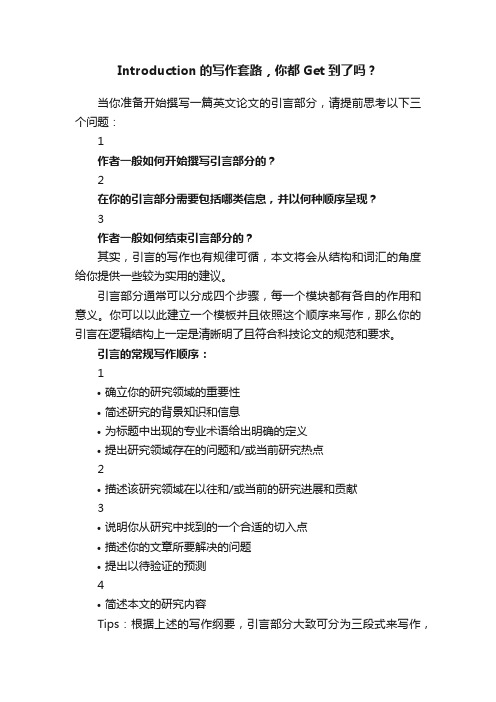
Introduction的写作套路,你都Get到了吗?当你准备开始撰写一篇英文论文的引言部分,请提前思考以下三个问题:1作者一般如何开始撰写引言部分的?2在你的引言部分需要包括哪类信息,并以何种顺序呈现?3作者一般如何结束引言部分的?其实,引言的写作也有规律可循,本文将会从结构和词汇的角度给你提供一些较为实用的建议。
引言部分通常可以分成四个步骤,每一个模块都有各自的作用和意义。
你可以以此建立一个模板并且依照这个顺序来写作,那么你的引言在逻辑结构上一定是清晰明了且符合科技论文的规范和要求。
引言的常规写作顺序:1•确立你的研究领域的重要性•简述研究的背景知识和信息•为标题中出现的专业术语给出明确的定义•提出研究领域存在的问题和/或当前研究热点2•描述该研究领域在以往和/或当前的研究进展和贡献3•说明你从研究中找到的一个合适的切入点•描述你的文章所要解决的问题•提出以待验证的预测4•简述本文的研究内容Tips:根据上述的写作纲要,引言部分大致可分为三段式来写作,其中2,3两部分可以合并到一个段落。
仅仅指出引言部分的写作顺序和写作内容可能还是会有些抽象。
接下去会讨论一些写作示例,帮助科研作者们更好地理解这种流程化引言写作的方式。
首先看一段比较简单的引言(10 sentences),但写作结构很完整,你可以来试着逐句分析一下作者在每个句子里想表达的内容。
The synthesis of flexible polymer blends from polylactide and rubberIntroduction1 Polylactide (PLA) has received much attention in recent years due to its biodegradable properties, which offer important economic benefits.2 PLA is a polymer obtained from corn and is produced by the polymerisation of lactide.3 It has many possible uses in the biomedical field1 and has also been investigated as a potential engineering material.2,34 However, it has been found to be too weak under impact to be used commercially.4 1阐明研究主题的重要性2提供一般背景信息3补充一些细节/特点4描述该领域存在的问题或当前研究焦点5 One way to toughen polymers is to incorporate a layer of rubber particles5and there has been extensive research regarding the rubber modification of PLA.6 For example, Penney et al. showed that PLA composites could be prepared using blending techniques6 and more recently, Hillier established the toughness of such composites.77 However, although the effect of the rubber particles on the mechanical properties of copolymer systems was demonstrated over two years ago,8 little attention has been paid to the selection of an appropriate rubber component.5从提出问题过渡到文献综述6综述该领域的主要研究项目7指出本研究的切入点/创新点8 The present paper presents a set of criteria for selecting such a component. 9 On the basis of these criteria it then describes the preparation of a set of polymer blends using PLA and a hydro-carbon rubber(PI). 10 This combination of two mechanistically distinct polymerisations formed a novel copolymer in which the incorporation of PI significantly increased flexibility.8概括本论文的研究内容9简述研究方法10声明研究结果对于每个部分,下面分别展示了一些更通用的句型、短语或词汇示例,你也可以把它们当做引言部分的写作模板,套用到自己的稿件中。
怎样写好英文论文的Introduction部分?
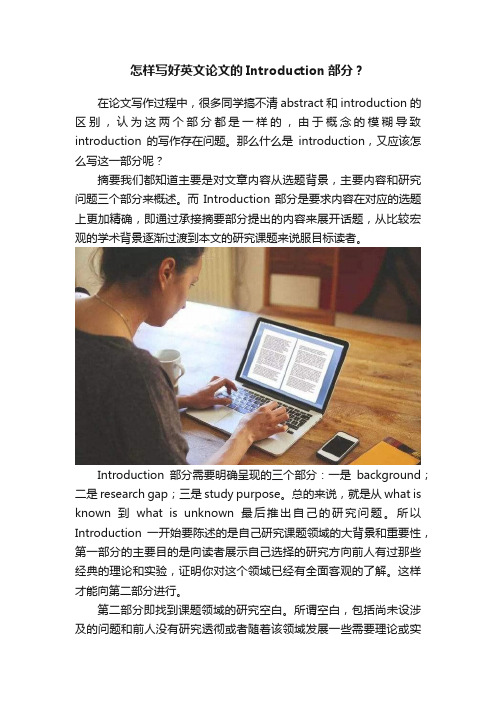
怎样写好英文论文的Introduction部分?在论文写作过程中,很多同学搞不清abstract和introduction的区别,认为这两个部分都是一样的,由于概念的模糊导致introduction的写作存在问题。
那么什么是introduction,又应该怎么写这一部分呢?摘要我们都知道主要是对文章内容从选题背景,主要内容和研究问题三个部分来概述。
而Introduction部分是要求内容在对应的选题上更加精确,即通过承接摘要部分提出的内容来展开话题,从比较宏观的学术背景逐渐过渡到本文的研究课题来说服目标读者。
Introduction部分需要明确呈现的三个部分:一是background;二是research gap;三是study purpose。
总的来说,就是从what is known到what is unknown最后推出自己的研究问题。
所以Introduction一开始要陈述的是自己研究课题领域的大背景和重要性,第一部分的主要目的是向读者展示自己选择的研究方向前人有过那些经典的理论和实验,证明你对这个领域已经有全面客观的了解。
这样才能向第二部分进行。
第二部分即找到课题领域的研究空白。
所谓空白,包括尚未设涉及的问题和前人没有研究透彻或者随着该领域发展一些需要理论或实验需要进行进一步修正。
这些都可以作为你了解到的研究空白,同时为你接下来的选题陈述奠定基础。
接下来就是要基于前两个部分的陈述点出本文的研究课题、研究意义和采用的研究方法。
写Introduction有几个需要注意的问题:首先在字数上不要过多,尤其在概述背景的部分,不要堆砌罗列文献,要选择与自己选题密切相关的著作或著名理论来陈述。
其次要时刻记得Introduction的目的是要让读者通过对这一部分的阅读对你的研究产生兴趣,即吸引读者。
Introduction属于论文中最难写的部分之一,这一部分的成败直接影响到你整篇论文的质量。
所以要在初稿完成后反复修改,不要过多赘述也不要一带而过。
怎么写论文的Introduction部分
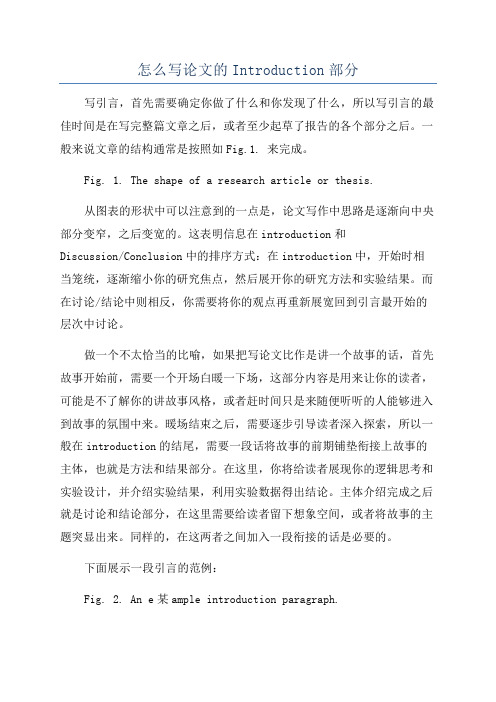
怎么写论文的Introduction部分
写引言,首先需要确定你做了什么和你发现了什么,所以写引言的最佳时间是在写完整篇文章之后,或者至少起草了报告的各个部分之后。
一般来说文章的结构通常是按照如Fig.1. 来完成。
Fig. 1. The shape of a research article or thesis.
从图表的形状中可以注意到的一点是,论文写作中思路是逐渐向中央部分变窄,之后变宽的。
这表明信息在introduction和
Discussion/Conclusion中的排序方式:在introduction中,开始时相当笼统,逐渐缩小你的研究焦点,然后展开你的研究方法和实验结果。
而在讨论/结论中则相反,你需要将你的观点再重新展宽回到引言最开始的层次中讨论。
做一个不太恰当的比喻,如果把写论文比作是讲一个故事的话,首先故事开始前,需要一个开场白暖一下场,这部分内容是用来让你的读者,可能是不了解你的讲故事风格,或者赶时间只是来随便听听的人能够进入到故事的氛围中来。
暖场结束之后,需要逐步引导读者深入探索,所以一般在introduction的结尾,需要一段话将故事的前期铺垫衔接上故事的主体,也就是方法和结果部分。
在这里,你将给读者展现你的逻辑思考和实验设计,并介绍实验结果,利用实验数据得出结论。
主体介绍完成之后就是讨论和结论部分,在这里需要给读者留下想象空间,或者将故事的主题突显出来。
同样的,在这两者之间加入一段衔接的话是必要的。
下面展示一段引言的范例:
Fig. 2. An e某ample introduction paragraph.。
如何写好论文的introduction
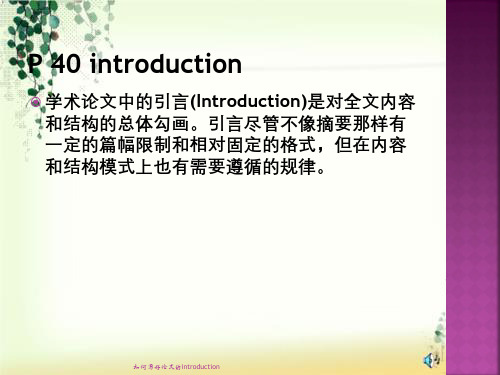
句型1:用表示否定意义的词例little,few, no或none of+名词作主语。如:
例 a.Little information/attention/work/
research… b.Few studies/investigations/
researchers/attempts… C.No studies/data/calculations… d.None of these studies/findings/
如何写好论文的introduction
题名的字数。题名不应过长。国外科技期刊一 般对题名字数有所限制。总的原则是,题名应 确切、简练、醒目,在能准确反映论文特定内 容的前提下,题名词数越少越好.
中英文题名的一致性。同一篇论文,其英文题 名与中文题名内容上应一致,但不等于说词语 要一一对应。在许多情况下,个别非实质性的 词可以省略或变动。例如:工业湿蒸汽的直接 热量计算,the direct measurement of heat transmitted wet steam。英文题名的直译中译 文是“由湿蒸汽所传热量的直接计量”,与中文 题名相比较,二者用词虽有差别,但内容上是 一致的。
c. Although considerable research has been devoted to…, rather less attention has been paid to…
例: Although there is much hope that threedimensional coupled models will lead to better understanding of the factors that control hurricane intensity and to increased reliability of hurricane intensity forecasts, the present generation of models may not have enough horizontal resolution to capture the full intensity of extreme storms.
如何写好论文的introduction

单击此处添加标题
单击此处添加文本内容,文字内容需概括精炼,建议与标题 相关并符合整体语言风格,语言描述尽量简洁生动。
单击此处添加标题
单击此处添加文本内容,文字内容需概括精炼,建议与标题 相关并符合整体语言风格,语言描述尽量简洁生动。
单击此处添加标题
单击此处添加文本内容,文字内容需概括精炼,建议与标题 相关并符合整体语言风格,语言描述尽量简洁生动。
如何写好论文的introduction工作内容阐述: 241837
• 添加相关内容: • 672904如何写好论文的introduction如何写好论文 的introduction • 228520如何写好论文的introduction如何写好论文 的introduction如何写好论文的introduction 202725 如何写好论文的introduction如何写好论文的 introduction如何写好论文的introduction
请输入您想要的文字请输入您想要的文请输入您想要的文请输入您想要的文字请输入您想要的文字
请输入您想要的文字字请输入您想要的文字您想要的文字请输入您想要的文请输入您想要的文请输
入您想要的文字请输入您想要的文字请输入
点击添加相关文字标题
分析关键点
请在此处添加文本请在此处添 加文本请在此处添加文本 请在此处添加文本
分析关键点
请在此处添加文本请在此处 添加文本请在此处添加文本 请在此处添加文本
分析关键点
请在此处添加文本请在此处添 加文本请在此处添加文本 请在此处添加文本
分析关键点
请在此处添加文本请在此处 添加文本请在此处添加文本 请在此处添加文本
点击添加相关文字标题
单击此处添加标题
单击此处添加文本内容,文字内容需概括精炼,建议与标题 相关并符合整体语言风格,语言描述尽量简洁生动。
好的论文Introduction,应该这样写!超实用干货分享!(附下载)
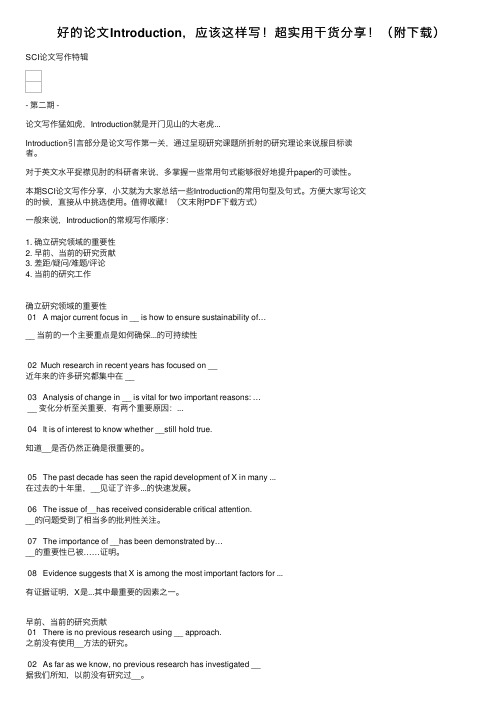
好的论⽂Introduction,应该这样写!超实⽤⼲货分享!(附下载)SCI论⽂写作特辑- 第⼆期 -论⽂写作猛如虎,Introduction就是开门见⼭的⼤⽼虎...Introduction引⾔部分是论⽂写作第⼀关,通过呈现研究课题所折射的研究理论来说服⽬标读者。
对于英⽂⽔平捉襟见肘的科研者来说,多掌握⼀些常⽤句式能够很好地提升paper的可读性。
本期SCI论⽂写作分享,⼩艾就为⼤家总结⼀些Introduction的常⽤句型及句式。
⽅便⼤家写论⽂的时候,直接从中挑选使⽤。
值得收藏!(⽂末附PDF下载⽅式)⼀般来说,Introduction的常规写作顺序:1. 确⽴研究领域的重要性2. 早前、当前的研究贡献3. 差距/疑问/难题/评论4. 当前的研究⼯作确⽴研究领域的重要性01 A major current focus in __ is how to ensure sustainability of…__ 当前的⼀个主要重点是如何确保...的可持续性02 Much research in recent years has focused on __近年来的许多研究都集中在 __03 Analysis of change in __ is vital for two important reasons: …__ 变化分析⾄关重要,有两个重要原因:...04 It is of interest to know whether __still hold true.知道__是否仍然正确是很重要的。
05 The past decade has seen the rapid development of X in many ...在过去的⼗年⾥,__见证了许多...的快速发展。
06 The issue of__has received considerable critical attention.__的问题受到了相当多的批判性关注。
- 1、下载文档前请自行甄别文档内容的完整性,平台不提供额外的编辑、内容补充、找答案等附加服务。
- 2、"仅部分预览"的文档,不可在线预览部分如存在完整性等问题,可反馈申请退款(可完整预览的文档不适用该条件!)。
- 3、如文档侵犯您的权益,请联系客服反馈,我们会尽快为您处理(人工客服工作时间:9:00-18:30)。
文献出处的标注
模式1:作者(年代)十谓语动词主动语态+研究 内容/成果
例:P40 the second paragraph
Also, Fay (1991) found cooperative group projects integrated into science class to be successful experiences for students.
句型5: Researchers have become increasingly interested in +研究领域
或:Researchers have recently focused their attention on +研究领域
Researchers have become more interested in environmental indicators.
P 40 introduction
学术论文中的引言(Introduction)是对全文内容 和结构的总体勾画。引言尽管不像摘要那样有 一定的篇幅限制和相对固定的格式,但在内容 和结构模式上也有需要遵循的规律。
第一层:
Introducing the general research area including its background, importance, and present level of development……………………………………………… ……………
There have been numerous publications over the last ten years on the need for nursing education to keep pace with the increase in knowledge of biological science.
句型1:研究主题+谓语动词be… . Spot welding (点焊) is the most widely used
joining method in the automobile manufacturing industry.
句型2: 研究主题+ has become … the battery technology has become increasingly
popular in automotive industry. Forest decline has become a favorite topic for
environmental studies.
句型3: Recently, there has been growing interest in / concern about + 研究主题
第三层:
Specifying the purpose of your research…………………………
第四层:
Announcing your major findings ………………………………
Outlining the contents of your
Read the following paragraph and summarize the main elements includ Introduction
模式2:研究内容/成果+谓语动词被动语态 +(作者年代)
Success at this Science Day was found to be linked to parental support (Czemiak 1996).
Reviewing previous research in this area………………………………………………………… …………
第二层:
Indicating the problem that has not been solved by previous research, raising a relevant question ……………………………
Forecast of the tracks of hurricanes (飓风)have improved steadily over the past three decades, owing to a combination of better observations and much improved numerical models. These improvements, along with advances in warning systems and preparedness for emergencies, have brought about a significant decline in loss of life.
In the 1990s there has been growing interest in the development of electric vehicles in response to the public demand for cleaner air.
句型4: Recently there have / has been extensive / increasing /numerous publications / literature / reporting on + 研究领域
引言开头(即第一层)最主要目的是告诉读者论 文所涉及的研究领域及其意义是什么,研究要 解决什么问题,目前状况或水平如何。也就是 说,开头要回答如下问题:
What is the subject of the research?
How is the research going at present?
